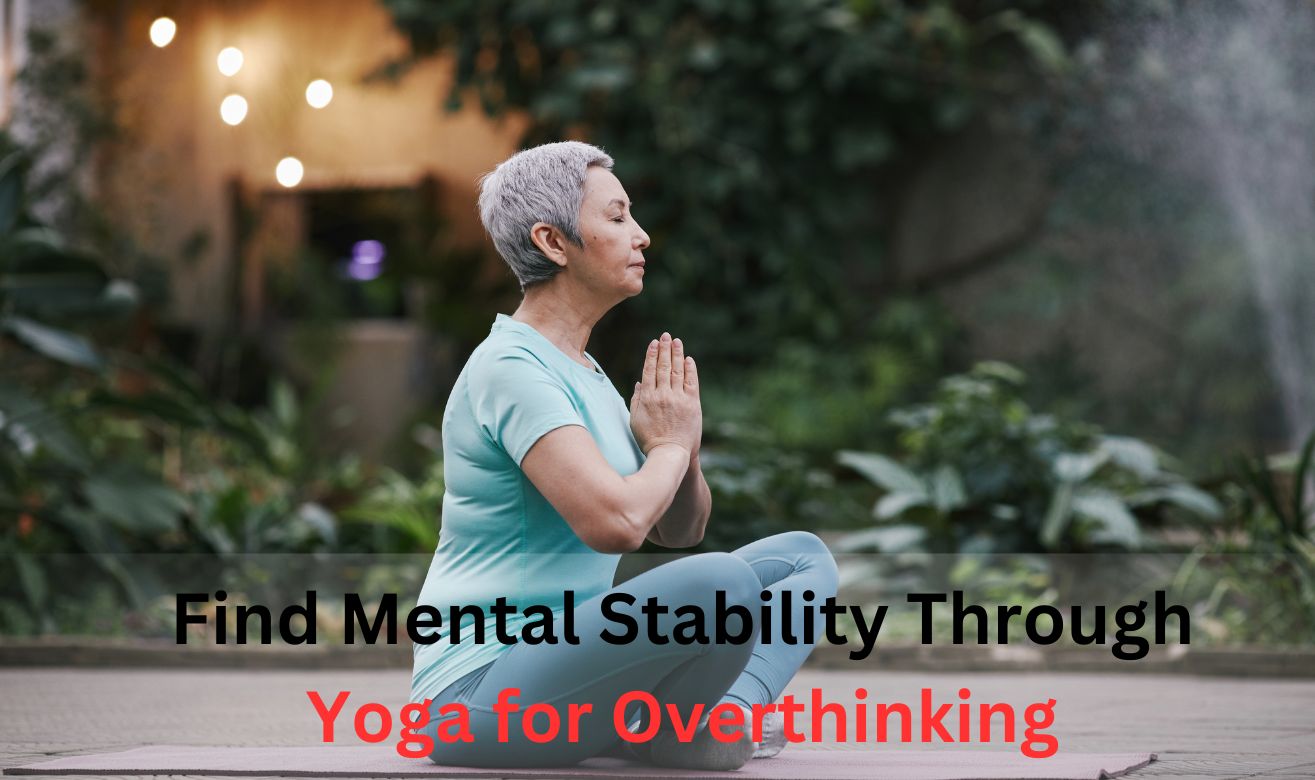Mental instability caused by the chain of thoughts is no minor issue; it affects cognitive functionality, disrupts emotional rhythm, and leads to a chronic state of inner turmoil.
Mental discourse is constant for people working in a high-pressure environment; it demands energy and attention.
Yoga for overthinking is more than a serene activity. It’s a strategic exercise to switch off cognitive bombardment, flip the neural behavior, and allow clarity via embodied self-awareness.

Understanding Overthinking and Its Impact on Mental Health
What Is Overthinking and Why Does It Happen?
Overthinking is a series of repeated analyses of thoughts, events, or decisions far beyond their utility.
It arises out of cognitive distortions like catastrophizing, perfectionism, and fear-based projections.
Such patterns originate in the limbic system and prefrontal cortex of the brain; they help in regulating emotions and making decisions.
The more these patterns are conditioned, the more habitual they become.
Common Mental and Physical Effects of Chronic Overthinking
Adverse Psychological and Physical Consequences of Chronic Overthinking:
- Neurological: Working memory capacity is decreased, cortisol secretion is increased, and the amygdala is very active.
- Psychological: Anxiety, anger, decision, fatigue, mood swings.
- Physiological: Muscle tension, gastrointestinal disturbances, insomnia, and chronic tiredness.
These effects tend to be systematic and not isolated. An overload of thinking activates these changes in the stress response at both the nervous system level and the endocrine instance.
Yoga for overthinking interferes with these signals and sets the body-mind interface into a different state.
How Yoga Helps Calm an Overactive Mind
The Science Behind Yoga and Mental Relaxation
Research studies show that yoga limits the detrimental effects of stress on one’s performance by manipulating the nervous system.
Yoga practice decreases activity in the Default Mode Network (DMN), a brain site involved with self-referential thinking and rumination.
Regularly practicing yoga increases the parasympathetic tone, lowers blood pressure, balances the activity between the two hemispheres of the brain, and promotes the secretion of neurotransmitters like GABA (gamma-aminobutyric acid) and serotonin, which fosters the state of calmness.
Key Yogic Concepts: Mindfulness, Breath, and Awareness
- Mindfulness prevents the mind from being caught up in repetitive thought cycles by drawing attention to its focus, either the task at hand or a sensation.
- Breath (Pranayama) blocks the automatic stress response by putting the parasympathetic nervous system in control.
- Awareness (Smriti and Dhyana) trains the practitioner to observe thoughts as they arise without attaching them emotionally.
This trio adds the brain switch from reaction to reflection that slows the pace of mental processing and increases clarity.
These cognitive aspects are embedded in the physical practice of yoga for overthinking.
Best Yoga Practices to Reduce Overthinking
Breathing Techniques (Pranayama) to Slow Down Racing Thoughts
Breath control is the quickest route needed to gain access to the parasympathetic nervous system to disrupt racing thoughts. Pranayama methods include:
- Nadi Shodhana (Alternate Nostril Breathing): Calming the mind via balancing the left-right brain hemispheres.
- Sama Vritti (Equal Breath): Syncs heartbeat and brainwave rhythm for emotional regulation.
- Bhramari (Humming Bee Breath): Stimulates the vagus nerve and silences neural activity.
These types of breath control directly restructure physiological manifestations of stress and therefore act at the root, blocking cognitive overload.
Yoga Asanas That Promote Inner Calm and Focus
Asanas should be selected according to their ability to regulate the nervous system and change awareness from the mental to the physical. They include:
- Viparita Karani (Legs-Up-the-Wall): Decreases adrenal activity and calms the sympathetic system.
- Paschimottanasana (Seated Forward Fold): Stimulates the parasympathetic nervous system through spinal flexion.
- Balasana (Child’s Pose): Encourages introspective thinking and neurological decompression.
- Setu Bandhasana (Bridge): Opens the chest, releases tension, and improves circulation to the brain.
Every posture, when augmented with control in breathing and sustained stillness, accumulated lessened mind overactivity.
Meditation and Mindfulness for Emotional Clarity
Meditation functions to develop awareness while reducing the power of distracting thoughts.
- Anapanasati (Breath Awareness Meditation): Serves as a primary meditative approach for controlling excessive thoughts through breath focus.
- Trataka (Fixed-Gaze Meditation): Focuses attention while reducing internal distractions.
- Japa (Mantra Repetition): The practice replaces continuous thoughts through repeated sound patterns, which help the brain create fresh pathways.
Through the combination of yoga practice with meditation, one can attain lasting mental strength while developing strength and increased cognitive capabilities.
Creating a Daily Yoga Routine for Mental Stability

Morning Yoga Flow to Start the Day With a Clear Mind
A morning yoga routine serves to prevent accumulated mental disturbances that occur during daily activities. A basic yoga flow consists of
- Repeating Sun Salutations thrice to boost blood flow and enhance brain function through oxygen delivery.
- Stand in a tree pose for mental stability training and balance development during this yoga practice.
- Practice Sama Vritti breathwork for five minutes to achieve proper breath control.
- Meditation starts with a short seated meditation where you set a mental intention.
This morning system establishes brain stability by avoiding disorder in the initial moments.
Evening Practices to Unwind and Detach From Stress
Using evening practice will help you both relax and separate yourself from stressful situations.
By following evening routines, people can reduce their exposure to excessive sensory stimulation. The following components should be included in an effective sequence:
- Restorative Poses: This includes Reclining Bound Angle Pose and Supported Forward Fold.
- Longer Exhalation Breathwork: Exhale-focused breathing through breathwork creates vagal tone activation.
- Mental Unloading Exercise: Compose your unprocessed thoughts through writing or spoken words before closing with ten minutes of silent meditation.
This combination prepares the nervous system for regenerative sleep and ensures an overnight cognitive reset.
Lifestyle Tips to Complement Your Yoga Practice
Healthy Habits That Reduce Mental Clutter
- Time Block: Prevents cognitive fragmentation and decision fatigue.
- Single Task: Avoidance of context-switching, leading to superficial thought patterns.
- Daily Planning: Organizes mental planning energies toward successful objectives.
- Silence Periods: Quiet time is scheduled to avoid overstimulation and to give the mind a break.
Each of the above habits complements yoga for overthinking through fostering energy conservation and diminution of external triggers.
The Role of Diet, Sleep, and Digital Detox in Mental Well-being
- Diet: Foods with fiber, magnesium, omega-3 fatty acids, and B-complex vitamins to support brain function.
- Sleep: Pursue consistent deep sleep cycles, facilitating memory consolidation with emotional regulation.
- Digital Hygiene: Turn off most notifications, watch your screen time in the evening, and spend hours free of screens daily.
Establishing this physiological baseline promotes the mental clarity established through yoga.
The Business Case for Mental Clarity: Why Leaders Should Invest Their Time in Yoga
Organizations that encourage mental clarity through yoga gain an immediate, tangible return of fewer sick days, better decision-making, lower burnout, and, hence, greater engagement.
For a leader, implementing yoga for overthinking into his own and team routines develops emotional regulation and strategic fixes. The ROI is not just cultural–it’s cognitive.
Final Thoughts: Embracing Yoga as a Long-Term Solution
Why Consistency Is Key for Mental Healing Through Yoga
Yoga is cumulative. Sporadic use offers momentary calm; regular practice creates neurological and behavioral shifts.
Just as overthinking becomes a habit, so can mental clarity—when trained through repeated engagement.
Taking the First Step: Where and How to Begin
Begin with simplicity:
- 10 minutes of breathwork
- A few grounding postures
- Quiet reflection before or after work
Progress is not measured by complexity but by consistency. Build gradually, sustain intentionally, and the results will be structural, not just symptomatic.
